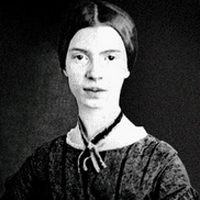Bring me the sunset in a cup by Emily Dickinson: Summary and Analysis
Bring me the sunset in a cup is one of the finest poems on Nature by Emily Dickinson. It is one of the typical poems of Dickinson displaying her approach to nature and its rich, vibrant and enigmatic sun setting in the evening. She depicts her immense pleasure to watch the fascinating evening. It has many startling and finest poetic phrases. The poem is obviously on the glories of Nature.

Emily Dickinson (1830-1886)
The sunset and the morning, the robin and the rainbow—all clearly cater the themes of nature. But the poet's treatment of a familiar theme is unusual and as charming as it is enticing.
The very first line is startling in its poetic intensity, where the sunset is reduced to the content of the cup. The lawn filled with dew, and the long, wide leap of the morning's brightness and the weaver bird spinning its nests are some of the attractions of the morning. The intensity of the first line challenges analysis and explanation. Such lines as these bring Emily Dickinson close to modern poets whose poetry is felt and communicated before it is understood.
The suddenness with which the world is brightened up with the glorious light of the morning is beautifully communicated here. The weaver bird incessantly weaving its blue nests. The robin's ecstasy cannot be valued in terms of the number of its notes. Tortoise's trips in the morning cannot be computed. The melody of the Robin bird reminds us of Keats's nightingale pouring its ecstasy from the heaven. The trees from which the robin is pouring forth its melody are astonished by its sweetness. The word 'cups' in the second stanza not mere measures of dew it suggests the number of flowers which the bee visits to rob them of their sweet honey. This is one of the oft-quoted phrases to illustrate Emily Dickinson's wit in poetic metaphors. The Bee, who is greedy with thirst, is personified as ''The Debauchee of Dews!'' The bee is described in startlingly poetic and apt sensual metaphor.
The poet indirectly suggests that behind the beauty of nature is the hidden hand of God, the architect of this universe. The questions in the stanza have all one obvious answer, namely 'God'. The rainbow is like a vast suspended bridge in the sky. The spheres or planets which obediently move in their orbits are bound by flexible twigs of supple blue of the sky. This is a highly poetic and imaginative description of the relation of planets among themselves and with the sky. The poet wonders who strings together the icicles that from the roofs of caves. The ‘stalactite' is not very poetic but adds to the mystery of God's creation.
The series of questions persist in the fourth stanza too; the poet reassures herself that the hand of God is there behind everything in this world. The spirit and intellect of man cannot understand this world. Man's soul is let loose from this world and as flies, it passes far from this pompous world. 'Passing Pomposity’ this phrase could also mean that the human soul released from this world is barely a picture of pomposity itself.
The poem is rich in metaphor and images like, sunset in a cup, 'leaping morning', 'rainbow's piers', 'withers of supple blue', 'fingers string the stalactite'. Some autobiographical tone too can be found this poem, such as the use of the personal pronoun 'me' and 'my'.
Cite this Page!
Sharma, K.N. "Bring me the sunset in a cup by Emily Dickinson: Summary and Analysis" BachelorandMaster, 11 Jan. 2018, bachelorandmaster.com/britishandamericanpoetry/bring-me-the-sunset-in-a-cup-summary-analysis.html.
Related Topics
Much Madness is Divinest Sense: Analysis
Renunciation: Summary and Analysis
Because I could not Stop for Death: Analysis
I Heard a Fly Buzz: Summary and Analysis
After Great Pain, a Formal Feeling Comes: Analysis
Success is Counted Sweetest: Summary and Analysis
I taste a liquor never brewed: Summary and Analysis
A Bird came down the Walk: Summary and Analysis
Hope is the Thing with Feathers: Analysis
I like to see it lap the Miles: Summary and Analysis
I had something that I called mine: Analysis
If I should Die: Summary and Analysis
I'm Nobody! Who are you?: Summary and Analysis
These are the days when the Birds come back
What Inn is this: Summary and Analysis
Exultation is the going: Summary and Analysis
Of Bronze-and Blaze: Summary and Analysis
A Clock Stopped: Summary and Analysis
I felt a Funeral, in my Brain: Summary and Analysis
Safe in their Alabaster Chambers: Analysis
There's a certain Slant of light: Summary and Analysis
To fight aloud, is very brave: Summary and Analysis
I like a look of Agony: Summary and Analysis
The day came slow-till Five o'clock: Analysis
 |
bachelorandmaster.com |